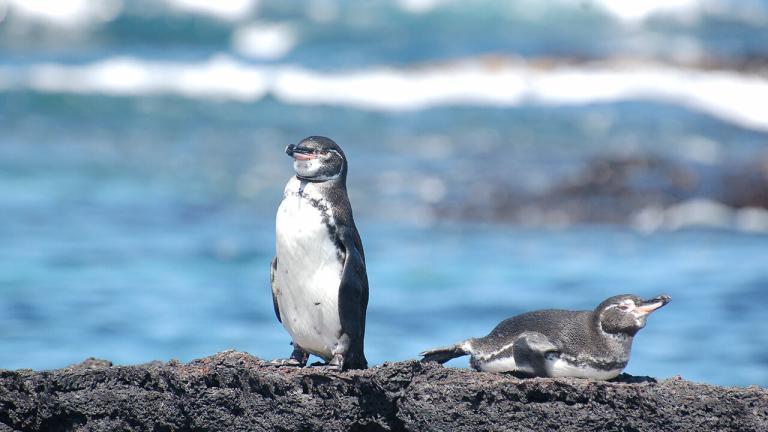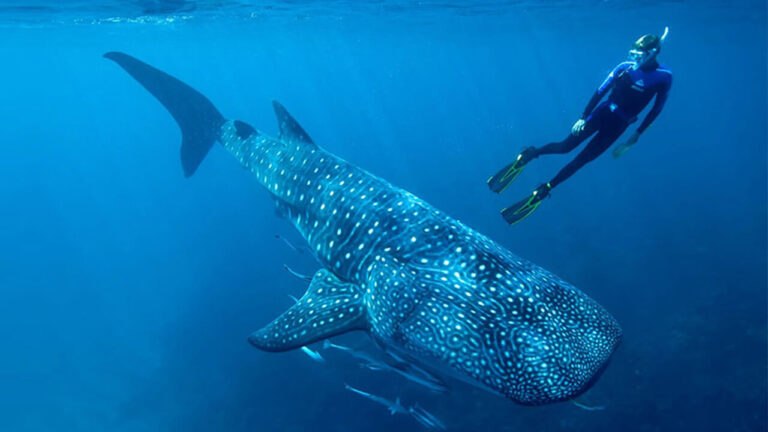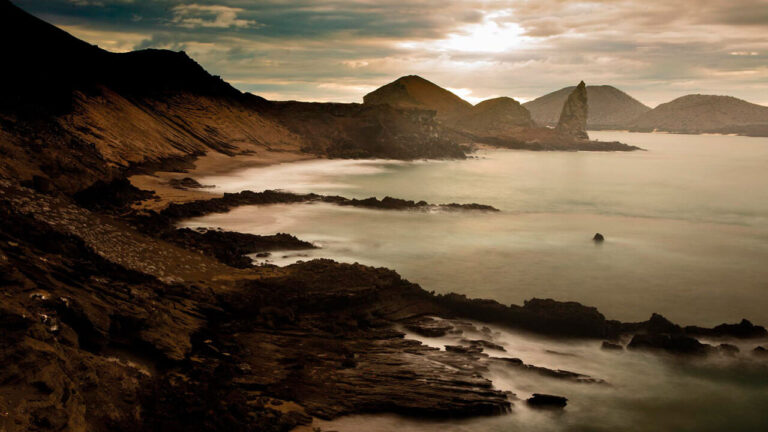Have You Ever Wanted to Walk in Darwin’s Footsteps?

[:en]If you hear the name Charles Darwin, most people immediately think, “theory of evolution” or about On the Origin of Species. The next thing that often comes to mind is the Galapagos Islands, the richly bio-diverse locale that became Darwin’s living, breathing laboratory.[:es]Si escuchas el nombre de Charles Darwin, la mayoría de la gente piensa inmediatamente, "teoría de la evolución" o sobre el origen de las especies. Lo siguiente que a menudo me viene a la mente son las Islas Galápagos, el lugar rico en biodiversidad que se convirtió en el laboratorio de respiración de Darwin.[:]
[:en]When hearing the name Charles Darwin, most people immediately think about the theory of evolution or On the Origin of Species. The next thing that often comes to mind is the Galapagos Islands, the richly biodiverse locale that became Darwin’s living, breathing laboratory. Both Darwin and the Galapagos have captivated the whole world’s interest for years. Not just because of the wild, pristine beauty of the Galapagos that still exists today but because of one man’s fascinating journey into science.
The Birth of a Theory
When Charles Darwin arrived at the Galapagos in the 1800s, he didn’t know the islands would hold such significance for his thoughts and theories in the world of natural science. In possession of a budding brilliant mind, the Galapagos quickly captivated him. Upon first glance, it seemed the islands were dry yet beautiful, but not the tropical paradise he initially expected. The lava flows of San Cristobal (the site of his initial landings) fascinated him, but he was still unaware of what was to come.
As he continued on his journey, he began to realize the diversity between the islands, but more importantly, the adaptations of the animals depending on their location. This would become the birth of his famed theory and, later, the subject of his book.
Darwin’s Need for Proof and How the Galapagos Answered
Darwin was a man who searched for evidence to settle his ideas. The Galapagos was the topic of many of the numerous journals he filled up during his life, which upon review held important notes—ones that proved there were variations between the animals on each island.
He noticed differences in the features and sizes of the animals, and how these adapted to the environmental features of each island. By the time he reached the end of his 5-week visit, in October of 1835, he had enough information to realize the significance of this small yet rich environment. He also began to realize the speed at which evolution had occurred in the Galapagos, making them a place of great importance to science and the world.
Walking in Darwin’s Footsteps
Today, the Galapagos Islands still serve as a living laboratory. Anyone who wants to walk in Darwin’s footsteps will find a place that still boasts the same proof — that species will adapt to their environments. This makes the Galapagos a draw for people interested in history, science, and adventure. The location’s integrity has been preserved for generations, and as a result it’s possible for people to follow the same path of Darwin and observe the same things he did. With different cruises and tours to choose from, you can
- Study the famous Galapagos tortoises. Many of the itineraries include a visit to the Charles Darwin Research Station and the Fausto Llerena Breeding Center on Santa Cruz. Here you can learn more about the large creatures that fascinated Darwin. You will also be able to view the tortoises and take notes of your own.
- Admire the incredible birds of the Galapagos. Each itinerary leads you to islands with huge populations of birds — many of them are the species that showed the variations that created Darwin’s theories.
- Visit the same islands and get to see the same sites Darwin did. Visit San Cristobal, see volcanoes, and go to other locations where Darwin roamed.
A Historical Journey
You don’t have to subscribe to Darwin’s theories or conduct scientific research to appreciate the historical significance of the Galapagos Islands. Don’t worry, you don’t have to be an experienced scientist – Darwin himself was an amateur when he first visited! All you need in order to have an incredible experience in the Galapagos is an interest in beauty, wild terrain, geology, flora, and fauna.
In the Galapagos, you’ll get to see thousands of animals behaving in their natural setting. You’ll also get to walk in timeless environments that host unique plant life and stunning views. You’ll also be able to learn more about the man who had a huge impact on the history of science. Learn interesting facts to take home with you, like the time when Darwin got seasick, or that it took him until 1858 to share his theories with the world.
The Galapagos Islands are an ideal travel destination for those with a thirst for knowledge. Galapagos is one of the most unique and interesting places in the world to visit.[:es]Tanto Darwin como las Galápagos han cautivado el interés de todo el mundo durante años. No solo por la belleza salvaje y prístina de las Galápagos que existe hasta hoy en día, sino por el fascinante viaje de un hombre a través de la ciencia.
El nacimiento de una teoría
Cuando Charles Darwin llegó a Galápagos en el siglo xix, no sabía que las islas tendrían tanta importancia para sus pensamientos y teorías en el mundo de las ciencias naturales. En posesión de una mente brillante en formación, las Galápagos rápidamente captaron su atención. A primera vista parecía que las islas, si bien bellas, eran secas, mas no el paraíso tropical que Darwin esperaba inicialmente. Los flujos de lava de San Cristóbal (el sitio de sus primeros desembarcos) le fascinaron, pero todavía no podía imaginar lo que sucedería.
A medida que continuaba su viaje, comenzó a darse cuenta de la diversidad entre las islas, pero, más importante aún, de las adaptaciones de los animales dependiendo de su ubicación. Esto se convertiría en el nacimiento de su famosa teoría y, más tarde, en el tema de su libro.
La necesidad de Darwin de evidencia y lo que las Islas respondieron
Darwin era un hombre que buscaba evidencia para asentar sus ideas. Las Galápagos fueron el tema de muchos de los numerosos diarios que durante su vida llenó, que al revisarlos probaron tener notas importantes, unas que probaban que había variaciones entre los animales de cada isla.
Notó diferencias en las características y tamaños de los animales, y cómo estas se habían adaptado a las características ambientales de cada isla. Para cuando llegó el final de su visita de cinco semanas, en octubre de 1835, tuvo suficiente información para darse cuenta de la importancia de este pequeño pero rico medio ambiente. También comenzó a darse cuenta de la velocidad con la que la evolución había ocurrido en las Galápagos, convirtiéndolas en un lugar de gran importancia para la ciencia y el mundo en general.
Caminando tras las huellas de Darwin
Hoy en día las Islas Galápagos siguen siendo un laboratorio vivo. Cualquiera que quiera seguir los pasos de Darwin encontrará un lugar que todavía cuenta con la misma evidencia: que las especies se adaptan a su entorno. Esto hace de Galápagos un atractivo para las personas interesadas en la historia, la ciencia y la aventura. La integridad del lugar ha sido preservada por generaciones, y como resultado es posible que los visitantes sigan el mismo camino de Darwin y observen lo mismo que él observó. Con diferentes cruceros y tours para elegir, usted puede:
- Estudiar las famosas tortugas Galápagos. Muchos de los itinerarios incluyen una visita a la Estación Científica Charles Darwin y al Centro de Reproducción y Crianza Fausto Llerena, en Santa Cruz. Aquí puedes aprender más sobre las grandes criaturas que fascinaron a Darwin. También podrás observar tortugas y tomar notas por tu cuenta.
- Admirar las increíbles aves de las Galápagos. Cada itinerario te lleva a islas con grandes poblaciones de aves; muchas de ellas son las especies que mostraron las variaciones que crearon las teorías de Darwin.
- Visitar las mismas islas y llegar a ver los mismos sitios que Darwin. Visite San Cristóbal, vea los volcanes y otros lugares donde Darwin deambuló.
Un viaje histórico
No es necesario suscribir a las teorías de Darwin o realizar investigaciones científicas para apreciar el significado histórico de las Islas Galápagos. No te preocupes, no tienes que ser un científico experimentado — Darwin mismo era un aficionado cuando desembarcó por primera vez. Todo lo que necesitas para tener una experiencia inolvidable en Galápagos es un interés por la belleza, la tierra salvaje, la geología, la flora y la fauna.
En las Galápagos podrás ver miles de animales comportándose en su hábitat natural. Podrás caminar en entornos atemporales que albergan plantas únicas y vistas impresionantes. También podrás aprender más sobre la persona que tuvo un gran impacto en la historia de la ciencia. Aprenderás datos interesantes para llevar a casa, como las circunstancias en que Darwin se mareó, o qué sucedió para que solo en 1858 sea capaz compartir sus teorías con el mundo.
Las Islas Galápagos son un destino ideal para aquellos con sed de conocimiento. Galápagos es uno de los lugares más únicos e interesantes del mundo para visitar.[:]




